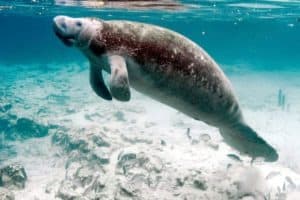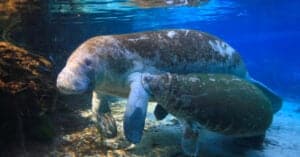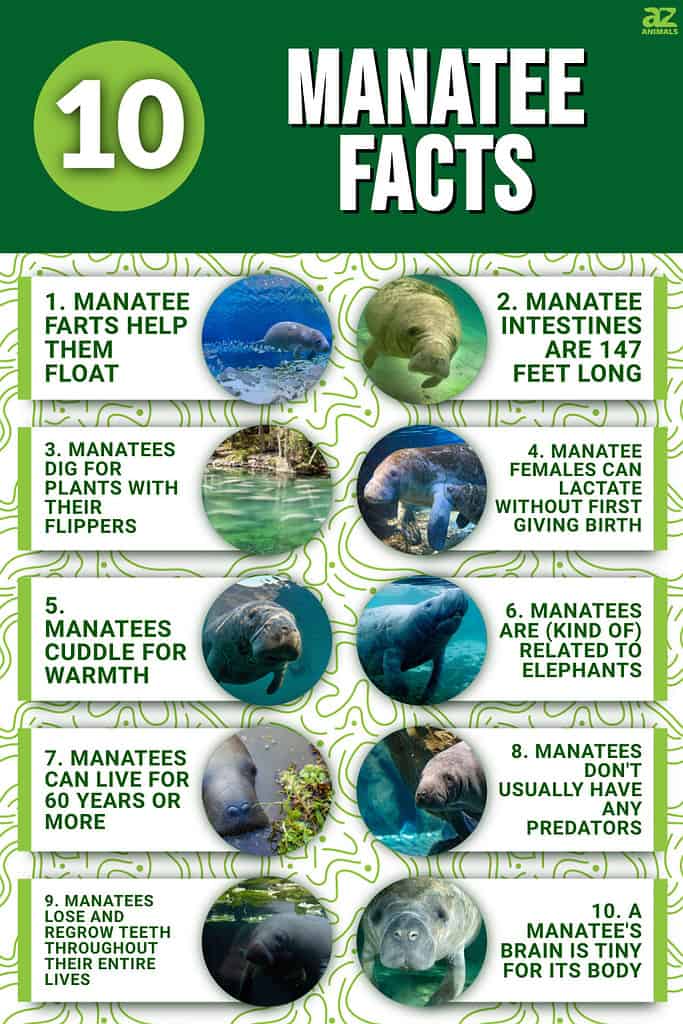
Manatees are large and gentle marine mammals that inhabit shallow, coastal waters. The manatee looks like a huge seal, but it’s not related to a seal. In addition, these incredible sea animals grow up to 10 feet long and weigh up to 1,000 pounds! Also called “sea cows,” manatees have interesting biology and behaviors. For example, did you know that a manatee needs to release gas to sink to lower depths in the water? Or that they’re loosely related to elephants? Keep reading to discover 10 incredible manatee facts that might surprise you!
1. Manatee farts help them float

A manatee passes gas to change its level of buoyancy.
©Thierry Eidenweil/Shutterstock.com
Manatees use flatulence to help them regulate their buoyancy. That’s right – manatees fart! Methane gas forms in the digestive tracts of many animals, including manatees. This gas develops when bacteria break down plant material that the animal has eaten. In manatees, methane gas builds up in their large intestines and leaves their bodies flatulence.
Storing gas inside a special intestinal pouch helps manatees float to the water’s surface. A manatee releases gas to sink to lower depths (yes, it farts!). This adaptation is beneficial for manatees because they often need to change depths in the water to find food or avoid the rare predator. In addition, manatees often swim to lower depths to prevent harm from boats and ships.
“Passing gas” is so vital to their buoyancy that a manatee’s ability to move well through the water is impaired if it’s constipated. So if you ever see a live manatee floating tail-up for a while near the surface of the water, it’s probably having digestive issues.
2. Manatee intestines are 147 feet long
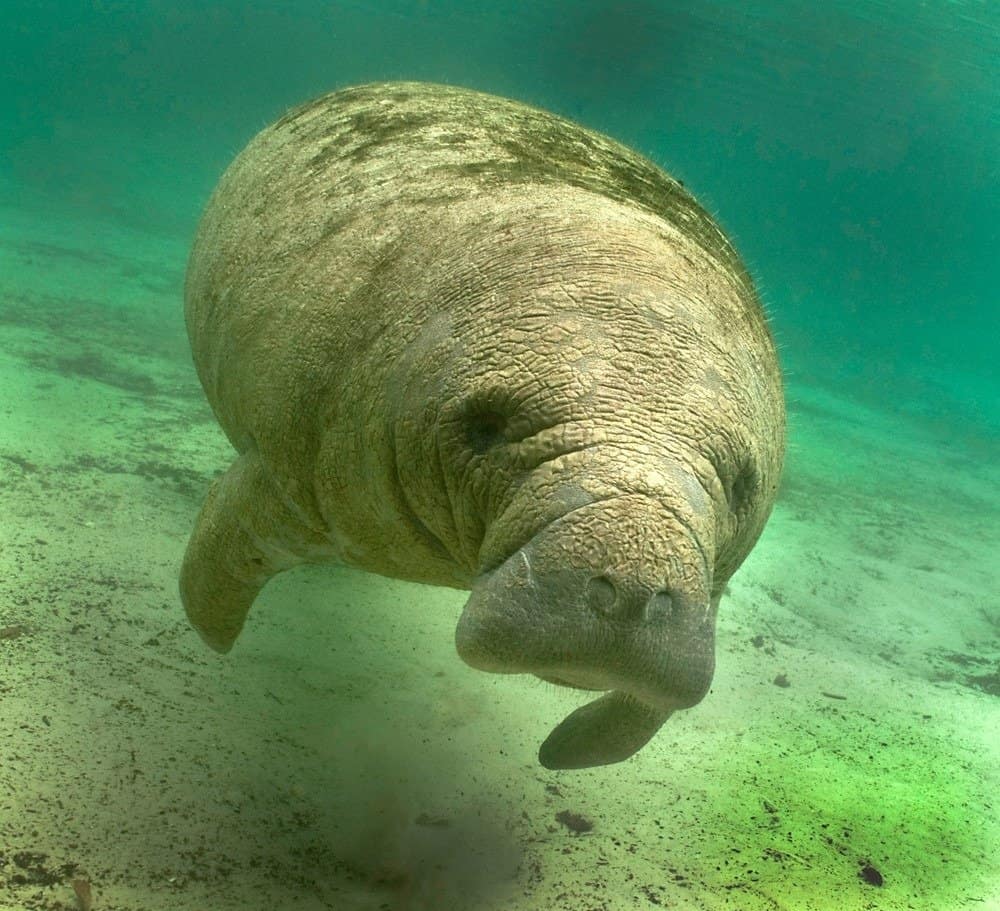
Plants make up most of a manatee’s diet.
©gary powell/Shutterstock.com
The manatee’s digestive tract is impressive, with almost 150 feet long intestines! Manatee intestines are very long because digesting their mostly plant-based diet takes extra time.
A study of Florida manatee GI tracts determined that the long length of their intestines is necessary for breaking down the fibrous plant foods they eat.
This digestive process can take a whole week! Fortunately, manatees can extract many nutrients from the plants they eat because of their long intestines, enlarged hindgut, and other special digestive system adaptations.
3. Manatees dig for plants with their flippers
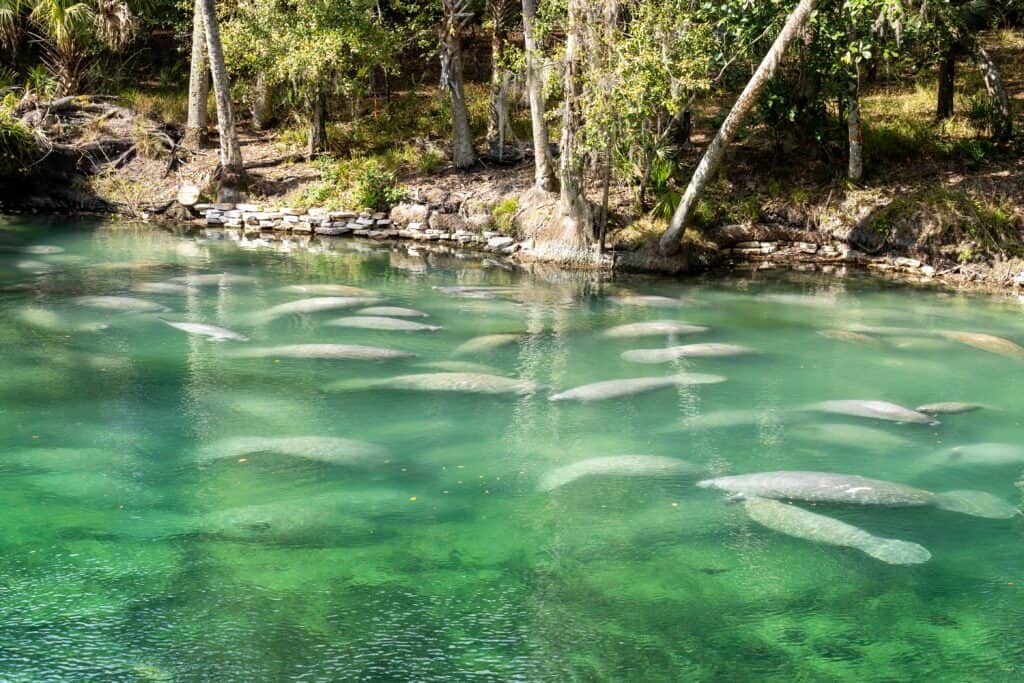
The southern coast of Florida is a popular area for manatee watching.
©JHVEPhoto/Shutterstock.com
Manatees use their large flippers to help them forage for food in the water and along the shore. First, they use their flippers to dig into the sand and mud for plants to eat, then to help bring the plants to their mouths when needed. Their large lips are also a big help with foraging for snacks.
Manatees eat more than 60 different types of freshwater and saltwater plants. Some of their favorites include:
- hydrilla
- eelgrass
- tape grass
- manatee grass
- water lilies
- mangrove leaves
A manatee also eats algae and other aquatic plants that grow on rocks and logs in the water. While they mostly eat plants, manatees also eat some marine animals. For example, they might use their flippers to help gather small fish, crustaceans, and mollusks.
If they can reach them, manatees sometimes eat from trees. They use their flippers to help them push up and reach low branches hanging over the water. Once close enough, they nibble on the leaves and bark of the tree. Manatees sometimes kill small trees by eating too much bark and leaves.
Of course, manatees also use their flippers to help them move around in the water, and their tails propel them forward by waving up and down.
These peaceful animals play an essential role in the health of their ecosystem, serving as keystone species by grazing on aquatic vegetation and keeping the water clean.
4. Manatee females can lactate without first giving birth
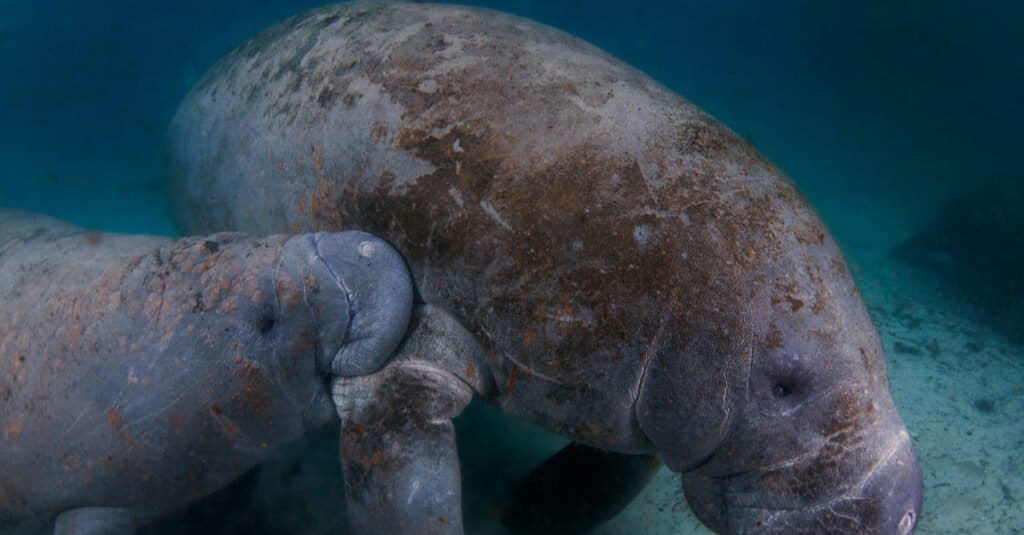
Female manatees feed their calves right behind their flippers.
©Greg Amptman/Shutterstock.com
Most adult female manatees can lactate spontaneously, so giving birth isn’t necessary for a female to make milk. This lactation usually happens when a manatee fosters another manatee’s baby.
Adult female manatees have two teats just behind their flippers that they use to nurse their calves. A manatee calf will stay with its mother for about two years before becoming independent, learning how to find food, or avoiding predators. Like their mothers, young manatees are primarily herbivorous and consume a wide variety of vegetation, including seagrasses, freshwater plants, and marine algae.
Mothers often help their calves feed by tearing off pieces of vegetation and bringing them to the surface for the calf to eat. Although they are gentle giants, manatees can be protective of their young and sometimes attack humans that come too close to a calf.
5. Manatees cuddle for warmth
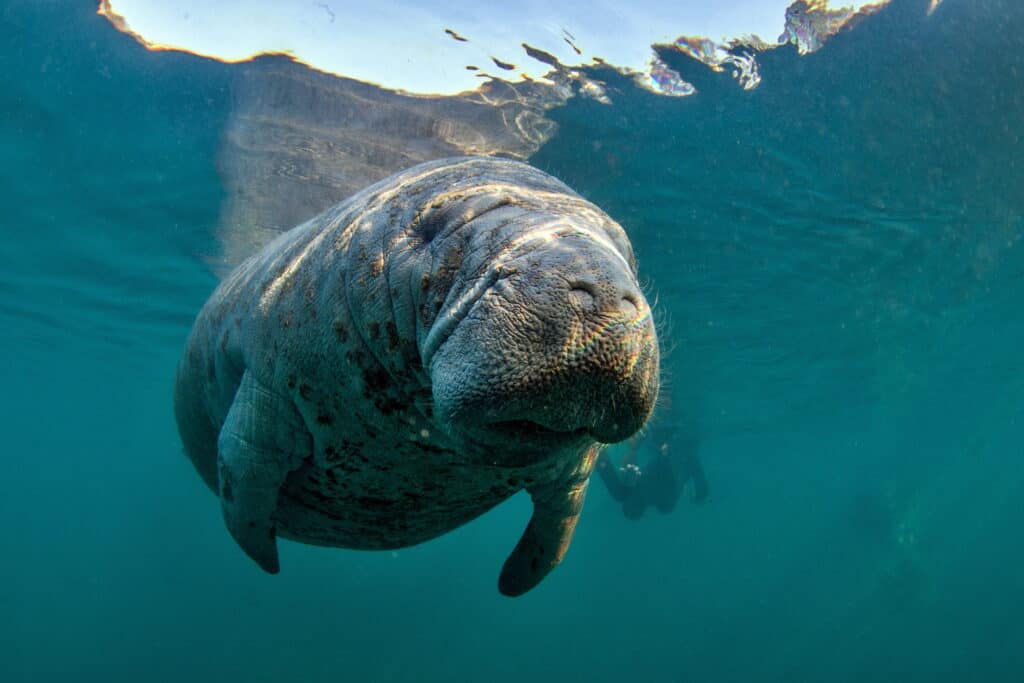
A manatee’s survival depends on staying in water above 68 degrees Fahrenheit.
©Tomas Kotouc/Shutterstock.com
The manatee is part of a subtropical species that don’t do well in cold water. Since it’s such a big animal, you’d think it was well-insulated with fat, but that’s not the case. Most manatees have only a thin layer of fat in their bodies. So, these sluggish animals have difficulty generating enough heat to keep themselves warm. So, manatees group in large herds if the water gets too cold.
It’s quite a treat to see manatees pressed together when cold! Usually, manatees are solitary animals unless they are mating or raising their young. But rare cold temperatures in their favorite habitats bring them together to cuddle for comfort and survival.
In general, manatees stay in warm waters throughout the year. And much like American humans, many manatees love to be in Florida for the winter. For these manatees, migration to other warm areas (like the coastal waters of Texas) happens in the summertime.
How dangerous is cold water for manatees? If water temperatures drop below 68 degrees Fahrenheit, manatees might experience hypothermia, and this dangerous condition could eventually lead to death. In addition, cold water can cause manatees to suffer from respiratory and other health issues.
6. Manatees are (kind of) related to elephants
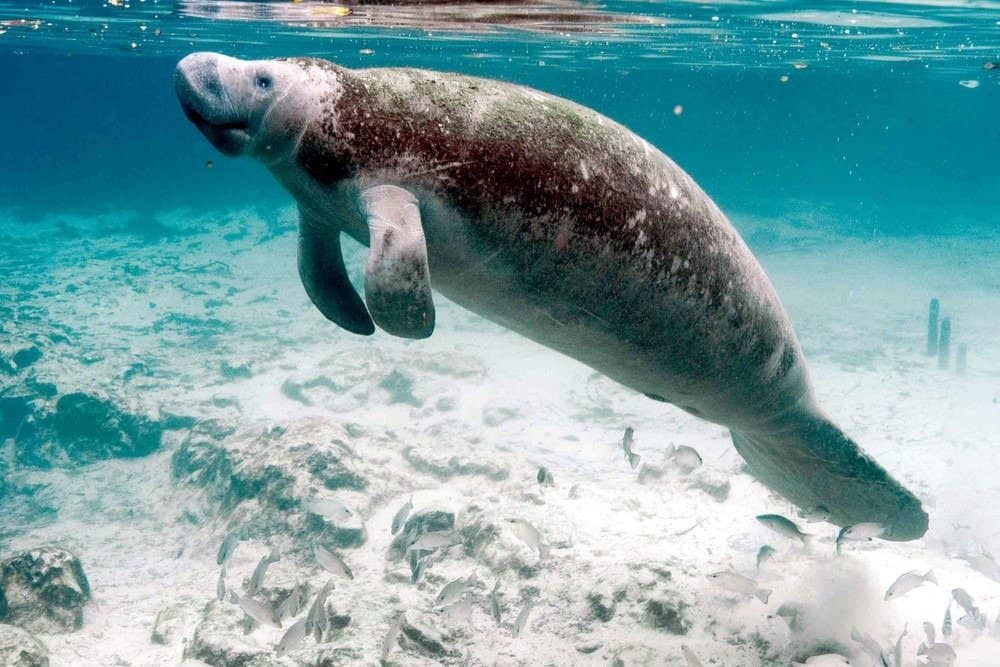
The manatee’s thick, gray, and leathery skin resembles elephant skin.
©Ramos Keith, U.S. Fish and Wildlife Service / public domain – License
If you think manatees are closely related to seals, whales, or walruses, think again. Manatees are closer to elephants than to other marine mammals. Though not directly related, manatees and elephants are part of a group of mammals called subungulates. A subungulate animal likely descended from ungulates – or hoofed animals – that lived in primitive times.
Other subungulates, along with manatees and elephants, include sirenians, hyraxes, and possibly aardvarks. Though they’re not directly related, these subungulates share some comparable DNA.
This shared DNA is why manatees have some characteristics similar to elephants, such as their thick, grey skin. The manatee’s thick skin helps to protect it from predators.
7. Manatees can live for 60 years or more
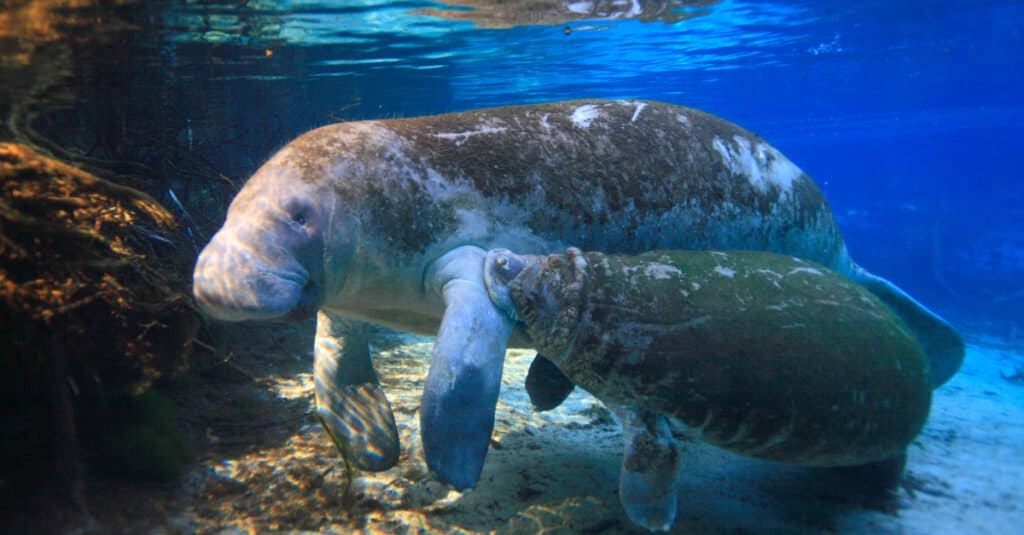
Healthy manatees live up to 60 years or more.
©Thierry Eidenweil/Shutterstock.com
The manatee’s slow way of moving through life is probably a significant reason they live so long. The fact that they have slow metabolism helps manatees live 60 years or more!
A 2009 article for the journal Discovery Medicine explains that lifespan is closely related to metabolic rate. The authors claim that the primary determining factor for how long animals live is their resting metabolic rate—the faster the rate, the shorter the lifespan. Therefore, the manatee’s slow metabolism contributes to its long life.
The oldest manatee ever recorded was a female named Snooty. She lived to be 69 years old! Snooty was born in captivity and died in an accident at her South Florida aquarium home.
8. Manatees don’t usually have any predators
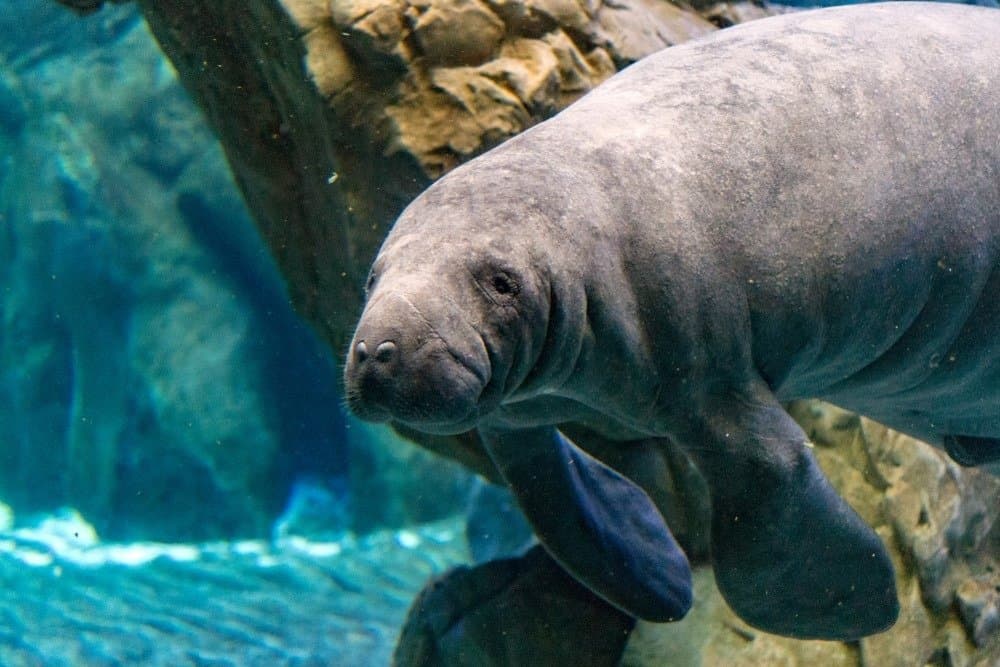
Predators rarely hunt the manatee.
©Andrea Izzotti/Shutterstock.com
Another reason manatees live for many years is that other animals don’t often hunt them. In addition, the manatee has few predators because it’s so big and, as a plant-eater, doesn’t compete for food with most marine animals.
Even so, a few animals will prey on manatees if given the opportunity. Some of these predators include alligators and sharks. While these predators aren’t a huge threat to manatees, they can still pose a danger if they encounter one.
Sometimes a shark might appear to be chasing a manatee to attack it but has another mark in mind. Following a manatee is an easy way for a shark to catch smaller fish that move out of the manatee’s way.
Manatees have few natural predators, but one of the most significant threats they face is from humans. Hunting and accidental collisions with boats are responsible for yearly manatee deaths. Manatee hunting is now illegal in Florida, and boat speeds are regulated to protect these gentle giants.
9. Manatees lose and regrow teeth throughout their entire lives
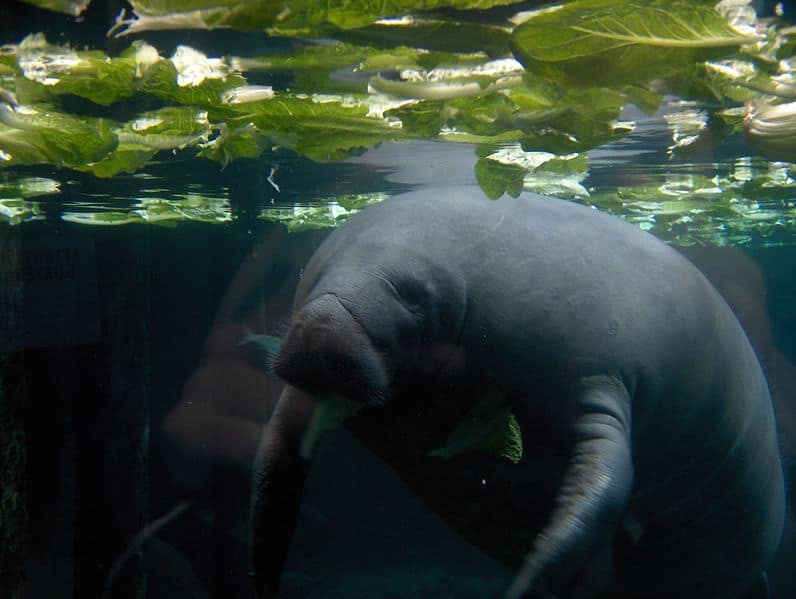
A manatee’s “marching molar” teeth help it chew plants.
Manatees have four sets of back teeth called “marching molars” that are constantly replaced. The manatee is the only mammal that keeps losing and replacing its teeth throughout adulthood.
Up to six times throughout its life, a new molar erupts at the back of the manatee’s jaw and pushes an old molar forward. Then, as older molars up front wear down, they fall out. This process is known as hind molar progression. It helps the manatee keep a sharp set of chompers for munching on their favorite foods!
10. A manatee’s brain is tiny for its body
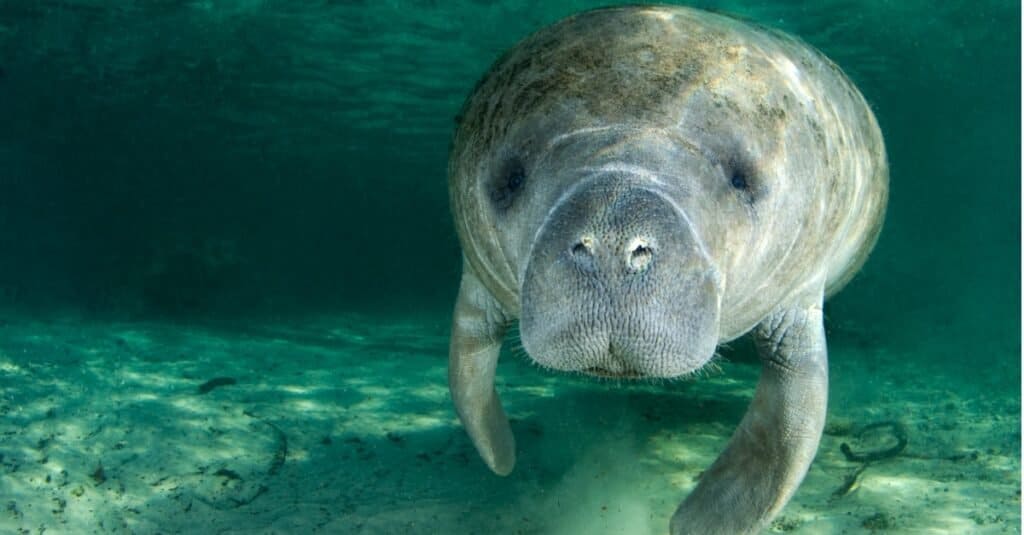
Manatees have brains similar in size to human brains.
©A Cotton Photo/Shutterstock.com
Compared to its body size, the manatee’s brain is relatively small. The manatee brain is similar in size to a human’s brain, but manatees are much larger animals. In other words, the manatee’s brain takes up less space in its head than a human’s brain.
But don’t let this size comparison fool you. Manatee brain-to-body ratio means that manatee bodies are enormous! Yet, their brain works just fine. Manatees are intelligent animals with similar comprehension skills as dolphins, and these gentle giants are slow-moving but not slow to learn.
Manatees are incredible animals!

This manatee is also called a “sea cow.”
©NASA / public domain – License
Manatees are amazing aquatic mammals with exciting adaptations that help them survive. First, they “pass gas” for buoyancy. Second, they avoid most ocean predators like sharks and alligators. And third, they eat a mainly plant-based diet and constantly replace their teeth! No wonder manatees can live up to 60 years or more.
Manatees spend much time alone but sometimes congregate in groups to socialize and play. They communicate with other manatees through various sounds, including chirps, whistles, and barks. Manatees also use touch as a way to speak, and they will often gently nudge or stroke each other with their noses or flippers. In addition, manatees are very affectionate creatures and often show affection by gently rubbing against each other.

Manatees are curious creatures that like to peek out of the water to check you out!
©Victor1153/Shutterstock.com
If you want to see some “sea cows” enjoying each other’s company, Florida is the place to be. The coastline around Southern Florida offers many areas for manatee-watching, especially between November and April. These are the months when the highest manatee populations are along the Florida coast. Check out manatee sightseeing tours near Fort Myers, West Palm Beach, and other coastal cities to see manatees galore!
The photo featured at the top of this post is © Lukasz Machowczyk/Shutterstock.com
Thank you for reading! Have some feedback for us? Contact the AZ Animals editorial team.



